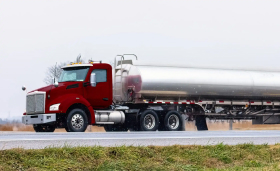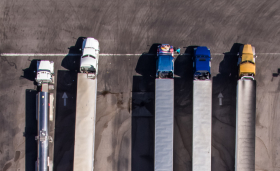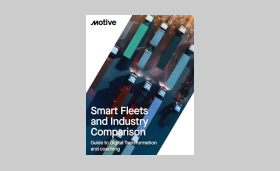On-demand webinar
Safety and fleet management for oil & gas.
Learn how Oil & Gas organizations use Motive to win big.
Duration: 1 hr
Webinar Details
Gaining visibility and keeping track of your fleet at jobsites that are sometimes remote can be tough for oil & gas businesses. Here at Motive, we understand those challenges and work hard to build solutions that help you safely increase productivity, predictability, and profitability.
Learn with Motive experts on the latest developments in safety, fuel, dispatch, messaging, and maintenance for oil & gas.
You’ll learn more about:
- How to gain visibility, prevent asset theft, and streamline your operation.
- Ways to improve safety and identify issues before they cost you money and business.
- How to manage maintenance, costs, and scheduling with technology to boost your bottom line.
Speakers
Transcript
Welcome everyone, to our webinar on how to transform oil and gas operations through automation with Motive. My name is Sina and I will be your host for today’s presentation. We are excited to have you join us as we discuss how to overcome industry challenges and unlock the potential of new technology in order to increase and automate productivity.
View More
0:00 | Sina Falaki
Welcome everyone, to our webinar on how to transform oil and gas operations through automation with Motive. My name is Sina and I will be your host for today’s presentation. We are excited to have you join us as we discuss how to overcome industry challenges and unlock the potential of new technology in order to increase and automate productivity.
We’ll also share our case studies of companies that have successfully implemented Motive’s platform to improve safety, gain visibility, facilitate compliance, and ultimately protect the bottom line. Now, before we start with the presentation, I wanted to introduce myself and my colleague here, Aman. I’ve been in the business for about seven years now, running industry marketing, and I lead industry marketing here at Motive. Aman.
0:55 | Aman Shahi
Hi there. Good to be with you all. My name is Aman. I’m a product director here at Motive, overseeing a number of our fleet management products. I’ve spent the last eight years in logistics technology of various kinds.
1:06 | Sina Falaki
Thanks, Aman. So we’ve got a lot to cover today, so let’s get started by reviewing our agenda. We’ll begin by discussing the growth and challenges they’re facing in the oil and gas industry. We’ll also talk about the discussion on the safety risks associated with oil and gas fleets and their latest technology and strategies for mitigating these risks.
We’ll have an overview of the benefits of real-time data and analytics for fleet management and how to use this data to improve decision-making and operational efficiency. And then we’ll talk about compliance. And this will discuss the importance of compliance in the oil and gas industry and the role of technology in helping companies meet regulatory requirements. And then last but not least, we’ll talk about Motive.
We’ll have an in-depth look at the unique features and benefits of Motive, the leading fleet management solution for the oil and gas industry. And then we’ll have a Q and A and wrap up. All attendees are welcome to ask any question at the end of the presentation, but we will wrap up with a summary of all of the key takeaways.
Now, the oil and gas industry is facing significant challenges, from safety concerns to supply chain disruptions and increasing regulatory pressures. To overcome these challenges and drive growth, companies must embrace digital transformation. According to a McKinsey report, successful oil and gas businesses will be those that unlock the potential of new technology to optimize and automate productivity.
Motive is a powerful tool that can help companies achieve this goal. With its advanced fleet management capabilities, Motive provides real-time visibility into operations, automates compliance, and improves safety. This results in a reduction of risks, as you can see here, increasing efficiency and cost savings altogether in order to overcome these industry challenges as one.
Now, before I go into the next question, I want to ask you and launch a poll here, to rate your company’s adoption of new technology on a scale of one to four. Perfect. And it’s interesting to see when we share the results. 43% have adopted some form of technology on the call today, which is fantastic. So we’ll talk a little bit about what that means in terms of silo data, in terms of also making sure that things integrate across the back office in the field.
Now, the oil and gas industry is facing significant economic challenges, including the rising cost of fuel, labor, maintenance, and repair. These rising costs are putting pressure on companies to find ways to increase efficiency and reduce expenses in order to maintain profitability and drive growth. US annual inflation has risen to 9.1% in 2022, the highest since late 1981. This led to an increase in operational costs, making it more difficult for companies to achieve profitability.
Supply chain disruptions have also affected more than 80% of oil and gas companies, further exacerbating the growth. To overcome these challenges, companies must find ways to improve efficiency, reduce costs, and mitigate risks. This can be achieved through the implementation of cost-saving measures, such as the automation of certain processes, optimization of fleet routes, and better inventory management altogether.
By identifying and addressing these costs, drivers, especially within oil and gas companies, can alleviate the pressure of their bottom line and pave the way for future growth. And one of the biggest obstacles in growth in the oil and gas industry is that lack of cohesive and integrated technology.
Now, we showed a poll just now that over 40% had some form of technology in today’s audience. But many companies still rely on a patchwork of disconnected systems that fail to provide a comprehensive view of operations. This fragmented technology in satellite data prevents businesses from overcoming the challenges they are facing and achieving their growth objectives.
Fragmented technology leads to inefficiencies, lack of visibility, and increased risk. It also hinders compliance, puts pressure on the bottom line, and limits the ability to make informed decisions. What we’ve seen from customers that we’ll discuss later today is that sat data makes it difficult to gain insights into operations.
How do you identify the right opportunities for improvement? How do you track progress toward your common goals? This lack of visibility leads to missed opportunities, increased risk, and makes it hard for businesses to stay competitive. The solution to these challenges is to adopt integrated, comprehensive technology solutions that could provide a unified view of operations and automate those processes.
By integrating all of these systems, companies have gained a truly comprehensive view of their operations and make data-driven decisions that improve efficiency, reduce risks, and mitigate costs. Now, managing an oil and gas fleet is a complex and challenging task that requires a holistic approach. In order to be successful, a lot of companies must focus on three key tenants safety, compliance, and profitability.
Safety. Ensuring the safety of your fleet is of the utmost importance. Not only is it a moral responsibility, but also it has a direct impact on your bottom line. By adopting advanced safety technologies and implementing best practices, companies can reduce the risk of accidents, lower insurance costs, and improve, by quite a bit, employee morale. Compliance, meaning regulatory compliance, is a must for any oil and gas company.
Failing to comply with regulations can result in fines, penalties, and often things that result in reputational damage. By automating compliance processes and adopting technology that can help you stay up to date with changing regulations, companies can reduce the risk of non-compliance and lower the cost of regulatory compliance and profitability. Ultimately, the goal of any business is to be profitable. Managing the oil and gas fleet is no different.
By improving efficiency, reducing costs, and increasing productivity, companies can improve their bottom line and pave the way for future growth. Now, we talked a little bit about how the oil and gas industry is facing significant challenges that require a comprehensive, integrated approach to fleet management. That’s where Motive comes in. We deliver a fully integrated suite of products that connect and automate oil and gas fleets, helping companies improve safety, compliance, and profitability.
Our platform is designed to provide a unified view of operations, one window giving companies real-time visibility into their fleet’s performance. It offers advanced analytics and reporting capabilities and allows companies to make data-driven decisions that improve efficiency and reduce costs. The platform also automates compliance processes, helping companies stay up to date with changing regulations and reducing the risk of non-compliance.
Additionally, Motive safety features such as real-time monitoring and incident management help companies to improve safety and lower the risk of accidents. Now, we’ll talk a little bit now around this section of how we offer safety features such as real-time monitoring and driver behavior, preventive maintenance, and incident management to improve safety and reduce the risk of accidents in oil and gas fleets.
Now, poor safety behaviors can have a significant impact on the company’s bottom line. According to industry statistics, 30% of profits are lost from safety accidents. Furthermore, 87% of accidents are avoidable and caused by correctable behaviors such as reckless driving, speeding, and lack of maintenance.
Our integrated safety platform is designed to address these behaviors by providing real-time monitoring of driver behavior, preventive maintenance, and incident management by providing actionable data and analytics. Motive enables companies to identify and address potential safety risks before they become accidents. The results speak for themselves.
One of Motive’s customers reduced safety incidents by 56% through the use of the platform. By improving safety and reducing the risk of accidents, companies can lower insurance costs, improve employee morale, and ultimately protect their bottom line proactively. Addressing safety is crucial to protecting your bottom line and creating a positive safety culture.
Our driver safety program is designed to do just that. It helps companies prevent accidents, exonerate drivers, and lower insurance costs. Our driver safety program includes in-cab alerts, and automates coaching so you can focus on what matters. With context and severity added to every video, fleet managers can easily coach drivers with powerful coaching tools that are embedded inside the application and video evidence.
There’s reliable video footage of all driving events that can exonerate drivers that are falsely accused of accidents and incidents, and by being proactive, right? We need to really underline that by being proactive in addressing these safety issues and reducing risk, companies can improve employee morale, lower their insurance costs dramatically, and ultimately protect their bottom line.
Our driver safety program provides the tools and data needed to create a safer, more efficient, and more profitable fleet. Now, the results kind of speak for themselves. Our advanced fleet management technology helps companies improve those three value propositions and ultimately improve their bottom line.
Our customers have seen significant results by implementing Motive solutions. With Motive, customers have seen a 35% reduction in road accidents through real-time monitoring of driver behavior, preventive maintenance, and incident management.
Exonerate drivers. 72% of our customers have been able to exonerate their drivers through the use of dashboard video footage provided by Motive’s platform, and lower insurance costs. By improving safety and reducing the risk of accidents, customers have seen an average of 25% reduction in insurance rates.
Strike, a leading oil and gas company implemented Motive’s advanced fleet management technology and saw significant results in safety and efficiency through the use of Motive’s driver safety program. Strike achieved an 82% reduction in drowsiness, 74% reduction in stop sign violations, 67% reduction in cell phone usage, and 57% reduction in hard braking.
Usher Transport, a leading oil and gas company implemented Motive to advance fleet management technology and saw significant results in safety and efficiency as well. Through the use of Motive’s driver safety program, Usher Transport was able to reduce accidents by 32%, improve driver coaching, and increase driver safety.
Our automated risk attention feature helped Usher Transport save time and improve the effectiveness of their coaching program by providing context and severity for every video, making it easier to identify and address those potential safety risks. By implementing Motive’s advanced fleet management technology, Usher Transport was able to improve safety, reduce their accidents, and improve driver coaching. Ultimately.
Now, gaining visibility into fleet operations is essential for oil and gas companies to identify opportunities for improvement and track progress toward common goals. Our platform provides real-time visibility into fleet performance and advanced analytics reporting capabilities that allow companies to make data-driven decisions that improve efficiency and reduce cost.
Now, in today’s fast-paced and ever-changing oil and gas industry, visibility is absolutely essential to managing operations and to stay competitive. We provide real-time insights that allow companies to see where their drivers are at any given moment, see where their assets are at any given moment, their materials, and equipment. Even in remote areas with Motive, companies can reduce dwell times, improve driver workflows, increase productivity, and achieve accurate location tracking.
This leads to faster collaboration, increased efficiency, and ultimately improved decision-making. The benefits of visibility are pretty clear. According to industry statistics, 35% of time is wasted on conflict resolution, cost overruns, and poor communication between the back office and inside the actual field itself.
Additionally, 29% of revenue is lost due to delayed cycle times and equipment loss. Motive’s platform provides that real-time visibility needed to optimize operations and reduce costs, ultimately protecting your bottom line. With Motive, you can gain the visibility needed to make data-driven decisions that improve efficiency, optimizes your operations, and reduces costs.
Now to take a look at a little bit about our Tracking & Telematics, how it works using smart geofencing predictive ETAs, and a single platform to harness fields of visibility across all of your physical operations. And, manually tracking service dates for every vehicle and asset can be burdensome only to delays in schedules and unexpected costs. Difficulty tracking engine PTO in hours worked can also lead to unexpected costs across the board.
According to industry statistics, 28% of loss in revenue is due to difficulty in accurately tracking service dates and 17% is due to asset failure. These costs can be avoided altogether by automating maintenance schedules and tracking engine PTO in hours worked. Now, our platform provides the tools to automate maintenance schedules, track engine PTO in hours worked, and monitor unauthorized use of vehicles and assets.
By automating these processes and gaining visibility into fleet operations, companies can reduce costs and improve efficiency altogether. Our platform provides these tools and data needed to create a more profitable fleet by tracking and telematics and increasing your vehicle runtime and reducing those repair costs.
Now, let’s talk about a customer now, Flying Start Transport. They are a leading oil and gas company. They implemented Motive’s advanced fleet management technology and saw significant results in efficiency and productivity. Through the use of an automated platform, Flying Star Transport was able to increase visibility into their operations, reduce costs, and increase productivity.
According to Flying Star, they’ve seen a 15% improvement in their efficiencies measured by hours per load. They’ve gained so much that they could work faster. Additionally, they saved nearly $50,000 each year using Motive with a 15% more efficient loading and higher productivity.
Now, we’re going to go through compliance a little bit before we go into why Motive and showcasing and a little bit more of our platform. But I want to talk a little bit about compliance because compliance is one of the most challenging things happening in the industry today, and staying compliant with the ever-changing regulations in the oil and gas industry can be a challenge for most companies.
Motive provides tools and automation to help companies stay compliant and reduce risk of non-compliance. With real-time visibility into compliance-related data and automated compliance processes, companies can lower the cost of regulatory compliance across the board. Now, legacy compliance solutions can be burdensome for drivers, especially back office staff, leading to increased costs and a higher risk of non-compliance.
Drivers can spend too much time managing available drive time and they’re filling out tedious inspection paperwork. Typically what I’ve seen sometimes, there’s been so much paperwork, it’s been more than the DMV. It’s what some drivers have said, while the back office can feel overwhelmed with manual compliance tasks and unable to quickly resolve driver issues.
Additionally, reactive CSA score management can lead to higher insurance costs and an increase in upkeep and compliance costs. According to industry statistics, there is a 25% rise in insurance costs, 68% increase in upkeep compliance costs, and three-x increase in regulatory compliance costs due to legacy compliance solutions. Motive’s platform provides an automated compliance solution that can help companies stay compliant, reduce costs, and mitigate risk.
With Motive, you can gain the visibility automation needed to make data-driven decisions that improve efficiency and reduce costs. Our automated compliance solution provides those tools needed to reduce the risk of non-compliance. Our solutions have proven to get results with customers seeing fewer hours of service violations, less time spent on compliance tasks, and a reduction in insurance costs.
According to our customers, they’ve seen a 50% reduction in HOS violations and a 66% reduction in time spent on compliance tasks. Additionally, our solutions resulted in a 25% reduction in insurance costs. Usher Transport, a leading fleet oil and gas company, implemented Motive’s advanced fleet management technology to improve their coaching and compliance.
With Motive’s automated compliance solution, Usher Transport was able to reduce hours-of-service violations, improve driver coaching, and increase driver safety. Our platform provided real-time visibility into compliance-related data and automated compliance processes which allowed us to transport to stay compliant, stay competitive, and reduce the risk of non-compliance. This helped the company reduce costs and improve efficiency.
Now we’re going to talk about a little bit about why Motive and I’m going to introduce back Aman, who you saw earlier today to talk a little bit about our differentiation and who we are.
20:56 | Aman Shahi
Great. Thanks so much, Sina. I appreciate the comprehensive overview of the problems facing folks in this industry and I’d love to give you guys a little bit more insight into who we are at Motive and what we offer as far as the solutions to these issues. So, at a glance, we are a pretty large business. We serve over 120,000 fleets with assets of various types across all the different verticals you can imagine having these physical economy needs.
Oil and gas is a major part of our business. We have over 700,000 vehicles and assets. Actually, this number has been moving pretty quickly. I think we’re now at 850,000 vehicles and assets that have our hardware deployed on those vehicles. Over a million drivers are relying on our mobile driver application and we have 150,000 facilities that have been geofenced and validated across the United States and Canada.
And so we have an all-in-one fleet management platform that can serve your needs in a couple of different ways. So at the base layer here, in this diagram on the right, you’ll see our IoT devices. We have a Vehicle Gateway. we have an AI Dashcam. We have an Asset Gateway. We have an Environmental Sensor. And we’re continuously adding more and more hardware products that integrate into this overall solution.
We take the data that we’re sourcing from these different pieces of hardware, these IoT devices, we stream those up to the cloud, and that all ends up in this middle layer, our mode of data platform. This is where a lot of the intelligence is happening. We are taking that real-time data. We’re conducting a bunch of machine learning artificial intelligence on that data.
We’re automating workflows for you, using those models and then we are using that to produce a number of different AI-powered applications which you see up at the top. And so we have tracking and telematics solutions that allow you to get visibility into where all of your drivers, your assets, your equipment, and their health. We have safety solutions. Automating.
A lot of the coaching that goes into making sure that your drivers are safe, providing exoneration with video evidence of any incidents that might happen, maintenance and fuel so, predicting any issues before they happen, and then also helping you think through your fuel burn and how much you’re actually spending to make sure you’re being as efficient as possible. And all of this is tied into a very large integration app marketplace.
So, we’re able to work with any other point solutions you might have in your overall enterprise software space to help you really leverage and get as much out of your entire technology stack as possible. So the difference here, I think, a very important point that we like to bring up. We build all of our own hardware, soup to nuts. We design it, we source all the parts, we test it, we QA it, we make sure that it meets the needs of our customers, which is critical to us.
And what that allows us to do is actually make sure that this hardware works reliably and in concert with all of the software products that we develop. And so we are the experts on everything from what you’re plugging into your vehicle to the AI models that are occurring on the back end, which allows us to really provide an exceptional level of service as well as support in the event that anything goes wrong.
And so we are really, really leaning into what we think is a huge change happening in the way that technology is leveraged in AI that is driving a lot of automation. This is impacting all the different aspects of our customers’ operations today, from how they are coaching drivers on safety, as I mentioned earlier, to how they are managing compliance needs, to how they’re planning for their maintenance requirements and schedules.
It is truly amazing to think how far technology has come. And we are a pioneer in taking this cutting-edge technology and applying it to the needs of oil and gas fleets across the industry. As I mentioned earlier, since we design all of our products, we make sure that everything meets a very, very high bar of excellence in design. From the way that these pieces of hardware look and function and whether they meet the form factor needs that you might have for your assets and vehicles, all the way to the most minute detail on how things look in our software.
And the key there is to make sure that this is easy to use, easy to interpret, and honestly, just delightful to spend a lot of your day in. We know that this is a critical, critical piece of software and part of your employees’ day-to-day lives in a very real way. And we take that responsibility very seriously in how we design every aspect of this. We are constantly soliciting feedback and working with our customers to make sure that this is meeting the needs that they have and building off of that point.
We have a best-in-class support infrastructure to make sure that we are helping you not only implement and deploy this, but also that it’s meeting your needs on an ongoing basis. So how do we do that? First off, deployment is where things really start. We have a very, very hands-on deployment process where we will look at all the different needs that you have specifically for the way that you operate, for your employee base, and we’ll scope out all the different activities that we kind of need to take care of.
We’ll have a kick-off where we go through all the different goals that we have for the implementation process. We’ll train anybody needed, whether that’s an executive who needs to understand reporting, whether that’s somebody who is in the back office who’s using our web product to manage things, or if it’s the drivers on the ground. We will make sure that everybody is up to speed on how this product and technology works.
And then as we roll this out, we will have regular check-ins. We’ll make sure that we’re getting any feedback on how this might be working or might have any challenges for the deployment process. And we’ll continue to iterate with you until this is meeting your needs. And finally, in the event that anything does go wrong because these are pretty complicated software suites and we know your business is very complicated, we make sure that we have hundreds of employees who are in support roles on the enterprise side, we have a dedicated support function that provides 24/7 resolution.
Each of these accounts will have a dedicated support engineer so that you have a go-to who can escalate issues that are particularly urgent. We are very proactive in that we are monitoring things at all times and focusing on our reliability on the sort of technical side. And so this is a culture of success and constantly iterating and making things better. And then we have a number of self-serve support resources from a multilingual help center to a chat assistant and then, of course, onsite or remote support for some of these major milestones as you get things up and running.
As you can see, our innovation has really helped the business scale. When we started rolling out a number of our products back in 2016, we were primarily focused on ELD compliance in the long-haul trucking space. We have continuously built out more and more solutions.
Today, as you can see on this set of logos, we really meet the needs of a number of different large, well-known companies across the ecosystem, including many oil and gas companies. And our excellence in a number of different areas has really been recognized by leaders in the space. We are continuously known for the excellence of our software, the user-friendly nature of that, and our ability to service our customers in a best-in-class way.
30:14 | Sina Falaki
Thanks for that, Aman. That was fantastic. I think now we’ll open the floor up to Q and A. We had a few questions come in. I guess the first question we’ll ask is, can Motive’s platform be used to optimize supply chain operations in the oil and gas industry?
I’ll go with that first, and then I’ll pitch it over to you. We’re able to optimize supply chain operations by really providing real-time visibility into location, status of assets, materials, and equipment that allows companies to really manage their supply chain and reduce the risk of supply chain disruptions. Aman, do you have any more to add to that question?
31:02 | Aman Shahi
Yeah, I think the way that we approach those kinds of problems is twofold. One, what are the insights that we can provide to you so you can optimize your own operations, where we take a lot of this data and give you insight you may not have had before, whether that’s where your vehicles are. Traversing all of our different reports on how the vehicle maintenance is going.
We make a lot of the data that has historically been sort of just raw and a large data set, very easy to access. And then in addition to that, we just are able to automate a lot of different things when we can. So how do you get an automated alert when a vehicle enters a certain geofence that you have configured? How do we make things very easy that may have been difficult before or a manual process?
32:01 | Sina Falaki
Fantastic. There was a question that came up around driver privacy. Now, with the rollout of dash cams, the question is, do drivers typically feel abrasive about this? And how do you typically overcome that? Aman, I’ll let you kind of leave with that.
32:20 | Aman Shahi
Yeah, it’s a great question. I think we have a lot of resources available since we’ve helped so many customers roll these hardware devices out to sort of figure out how to answer those questions. That’s one of the aspects of our very white glove implementation support that we pride ourselves on. We’ll help you train drivers on why this is so important.
What we found is drivers end up becoming much, much safer once we have these dash cams in place. And it can be difficult to have the conversation. But when you clearly outline the benefits to both the driver’s safety as well as the fleet, this tends to be something that they understand, and I think is becoming more and more the norm in the industry. Safety is so critical and our dash cams are not as concerning as they once were from the driver’s perspective. I think folks understand that this is a critical part of making sure everybody is safe.
33:33 | Sina Falaki
Love that. Just to add to that, there was a response that we got today from a fleet manager who talked about protecting the business, ultimately. Right? And making sure that every single person on the road needs to be protected in some way or another and how that kind of rolls up into the overall company. So that was great. Okay.
33:58 | Aman Shahi
I should mention on that front, one point I forgot to bring up is how beneficial it is for the driver, him or herself. If there’s an exoneration opportunity, this could save that driver’s license. And it’s very tough sometimes to actually have deterministic data otherwise to prove that what the driver says happened, happened. So that’s a very key way of making that point as well.
34:25 | Sina Falaki
It’s huge. And even like when we talk about in the oil and gas sector, when we talk about most operators aren’t drivers, right? And you think about that as a whole, is that when you’re transporting, you really want something to help you kind of coach on a different terrain.
How do you turn or what are the possible routes to take, or how do you improve fuel usage here and there? Or how do you bring in better ETAs by doing better things on the road? Not a lot of cameras can provide that, right?
It’s pretty incredible to see our coaching being able to just one on one with the camera and the driver being coached. And that information oftentimes doesn’t even need to get sensitive or fleet manager, which is beautiful, right? So there’s great things about that.
35:17 | Aman Shahi
Yeah. To build off of that point, I think in a world where your company may not be a transportation company, but driving events occur, you probably don’t have an incentive to set up an entire safety program with a safety manager. It’s just an example of one type of fleet that we’ve heard about in oil and gas. But you still care about safety. It’s something that you absolutely want to improve.
Our automated coaching platform just takes care of that for you. So it’s a good example of where we’re able to actually improve your fleet’s operations with almost no manual effort on your part. That’s the kind of thing we can automate. It’s almost a set of activities we’re not even making easier. We’re literally doing them in a way that you’ve never been able to do. So it’s not just about making what you do today more efficient. It’s about adding in modules or technology that does things you haven’t historically done and provides a lot of value.
36:17 | Sina Falaki
And for the last question is, why do we build our own hardware? I’ll let you take that.
36:28 | Aman Shahi
Yeah, it’s not the easiest path. There’s a lot of providers out there who white-label hardware that others produce and they slap their logo on there. And that’s an approach, I would argue it’s sort of the easy way out. You end up with a situation where, sure, you have all these different hardware components, but when you actually see and practice what happens, they just don’t play together well.
You’ll have a dash cam that doesn’t sync up with your tracking product on your dashboard. You might have reliability issues, and then when you reach out to support, they actually have to go to another third party in order to understand what’s going on in a deeper level. We really believe that in order to provide excellence and service, you have to have ownership of every single aspect of what’s going on from the base level all the way up through the AI models.
And the optimization when you reach out to that support agent, if they need to, can escalate directly to a product team that has built that hardware from day one, has designed it, has a very clear understanding of everything that could go wrong or what might be causing an issue you have. So we strongly believe that building your own hardware is the only way to really provide that excellence in design and service and reliability and support.
37:53 | Sina Falaki
Thank you for that. And with that, I’ll say that we are going to wrap up this webinar. If you have any other questions, please feel free to go to gomotive.com/solutions/oil-and-gas or request a demo from one of our talented reps that are more than happy to assist you in a full-blown demo of our platform. It was a great time today speaking with you all. Thank you for all the fantastic questions and looking forward to the next time. Thank you.
38:27 | Aman Shahi
Thank you.
Learn more about Motive’s fleet management solutions for oil and gas.
Request a demo to see Motive in action.





